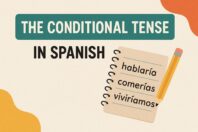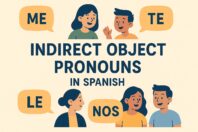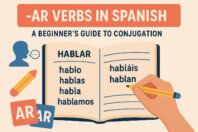Spanish Grammar: How To Stop Confusing Traer vs Llevar

Get our free email course, Shortcut to Conversational.
Have conversations faster, understand people when they speak fast, and other tested tips to learn faster.
More infoTraer vs Llevar are two of those Spanish verbs that many beginner students easily confuse.
The confusion normally comes when you try to directly translate from English, or when two verbs have a similar meaning (e.g. Ser vs Estar or Saber vs Conocer) .
The good news is that knowing when to use Traer (to bring) vs. Llevar (to take) isn’t too complicated, once you understand the context in which each verb is used.
Over time, using both verbs will be second nature.
In this post, we will go deep on the uses of each verb, starting with Traer, which as you already know, means “to bring”.
Spanish Grammar: How To Use Traer
Traer is the simplest of the two verbs to understand, since it only has one main use: to bring.
However, traer can only be used when you are at location A, and you need to go to a different location in order to get something/someone and bring it back to location A.
This means that when traer is used, we know that speaker is already at the destination of the action, which is contrary to llevar.
Let’s take a simple example.
Imagine that you dropped into your friends house to say hello on the day of his party, which will take place in a couple of hours.
So you ask…
- Do you want me to bring something to eat later? – ¿Quieres que traiga algo de comer más tarde?
In this example, the action involves you leaving the location you’re in, going to get food and returning back to the same location later.
Let’s look at another example.
- If you want to bring something, I’d like Chinese food – Si quieres traer algo, quisiera comer comida china
In the above, the two speaking are already at the location where the food is to be delivered and the speaker is clearly leaving but will return later to bring the food.
As we mentioned, traer can be used in relation to people, as well as things.
- Your aunt arrived half an hour ago, I have to go bring her from the airport – Tu tía llegó hace media hora, tengo que ir a traerla del aeropuerto
In this case, the speaker is asking if he has to leave his current destination in order to collect the other persons aunt, and then return to the original destination.
That’s enough examples for now.
Let’s lets see how you can conjugate the verb traer in the most common verb tenses.
Spanish Grammar: How To Conjugate Traer
| Traer – To bring | ||||
| Subject | Simple present
(Bring) |
Simple past
(Brought) |
Imperfect past
(Used to bring) |
Simple future
(Will bring) |
| Yo | Traigo | Traje | Traía | Traeré |
| Tu | Traes | Trajiste | Traías | Traerás |
| Él/Ella | Trae | Trajo | Traía | Traerá |
| Nosotros | Traemos | Trajimos | Traíamos | Traeremos |
| Ustedes | Traen | Trajeron | Traían | Traerán |
| Ellos | Traen | Trajeron | Traían | Traerán |
Now that you understand how and when to use traer, we can move on to llevar, which has several uses.
Spanish Grammar: How to use Llevar
There’s a good chance that you understand llevar as “to take”, which is correct.
However, this verb can be used in many different ways, depending on which context you wish to you use it with.
1) To take
The basic and most used one, meaning to carry something, somewhere.
- We have to pick up some ice and drinks for the party tomorrow – Mañana tenemos que llevar hielo y bebidas para la fiesta
The difference between llevar and traer is clear here, as llevar is used when you leave your current destination and take something to a new destination, whereas traer is used when you temporarily leave your current destination, to bring something back to that original destination.
2) To have (amount of time) doing
Used to describe how much time someone has spent performing an action.
- We have been waiting all day for you – Llevamos todo el día esperando por ti
- I’ve been in Colombia for 3 years – Llevo 3 años en Colombia
3) To give a ride
- Can you take him home after the concert? – ¿Luego de el concierto lo puedes llevar a casa?
4) To be an ingredient in a recipe
This only works within a cooking context e.g. naming ingredients in a recipe, or adding an ingredient.
- Remember that recipe needs more cocoa than flour and more sugar -Recuerda que esa receta lleva más cacao que harina y más azúcar
5) To have or quantify an advantage.
Usually to illustrate the precise difference between two people with similar points to compare.
- She started a bit earlier, she’s only one semester ahead of you in that career Ella empezó un poco antes, te lleva solo un semestre en la carrer
- My brother is 5 years older than me but we’re almost the same height now – Mi hermano me lleva 5 años pero casi somos del mismo tamaño
Now that you know the exact differences and many uses of llevar, we can explore the conjugation.
Spanish Grammar: How To Conjugate Llevar
| Llevar – To take | ||||
| Subject | Simple present
(Take) |
Simple past
(Took) |
Imperfect past
(Used to take) |
Simple future
(Will take) |
| Yo | Llevo | Llevé | Llevaba | Llevaré |
| Tu | Llevas | Llevaste | Llevabas | Llevarás |
| Él/Ella | Lleva | Llevó | Llevaba | Llevará |
| Nosotros | Llevamos | Llevamos | Llevábamos | Llevaremos |
| Ustedes | Llevan | Llevaron | Llevaban | Llevarán |
| Ellos | Llevan | Llevaron | Llevaban | Llevarán |
Traer vs. Llevar: Practice
Can you tell the difference between traer vs llevar? Add the correct conjugation below:
1. Te ________ algo que envió mi mamá, espero que te guste (I brought you something my mom sent, hope you like it)
2. Hay que ________ varios trabajos a su oficina durante este mes (We have to bring him several projects to his office during this month)
3. ¿________ todo lo que te pedí? (Did you bring everything I told you to?)
4. ________ una o dos semanas en la lista de espera. (We have been on the waiting list for one or two weeks)
5. Te ________ un regalo por tu cumpleaños (I brought you a birthday present)
6. ________ dos o tres días construir algo así (It took one or two days to build something like that)
7. Te ________ 20 años de experiencia, es bueno aprender de ellos (They are 20 years in experience ahead of you; it’s good to learn from them)
8. El distribuidor se encarga de ________ todos los productos a donde deben ir (The distributor takes care of taking all the products where they must go)
9. Solo estamos esperando, ya que ________ el último cargamento (We are waiting, since they are bringing the last shipment)
10. En vez de ________ mantequilla, esta versión utiliza aceite y menos huevos (Instead of butter, this recipe uses oil and fewer eggs)
11. ________ tres o cuatro invitados a comer todas las semanas (We used to bring in three or four guests for dinner every week)
12. Si vas a la cocina ________ algo de tomar (If you’re going to the kitchen bring me something to drink)
13. ¿Quieres que te ________? Me queda en el camino (Do you want me to take you there? It’s on my route)
14. Tenemos que devolverle eso, ________ a su casa (We have to give that back to him, take it to his place)
15. Ellos ________ los trajes a la lavandería (They took the suits to the laundry)
Answers:
1. Te traje algo que envió mi mamá, espero que te guste.
2. Hay que llevar varios trabajos a su oficina durante este mes.
3. ¿Trajiste todo lo que te pedí?
4. Levo una o dos semanas en la lista de espera.
5. Te traje un regalo por tu cumpleaños
6. Llevó dos o tres días construir algo así.
7. Te llevan 20 años de experiencia, es bueno aprender de ellos.
8. El distribuidor se encarga de llevar todos los productos a donde deben ir.
9. Solo estamos esperando a que traigan el último cargamento.
10. En vez de llevar mantequilla, esta versión utiliza aceite y menos huevos.
11. Llevábamos tres o cuatro invitados a comer todas las semanas.
12. Si vas a la cocina tráeme algo de tomar.
13. ¿Quieres que te lleve? Me queda en el camino.
14. Tenemos que devolverle eso, llévalo a su casa.
15. Ellos llevaron los trajes a la lavandería.



